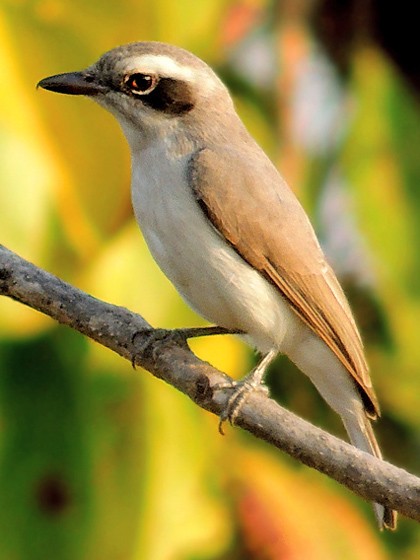Common Woodshrike
A species of Woodshrikes Scientific name : Tephrodornis pondicerianus Genus : Woodshrikes
Common Woodshrike, A species of Woodshrikes
Botanical name: Tephrodornis pondicerianus
Genus: Woodshrikes
Content
Description General Info
 Photo By Shantanu Kuveskar , used under CC-BY-SA-4.0 /Cropped and compressed from original
Photo By Shantanu Kuveskar , used under CC-BY-SA-4.0 /Cropped and compressed from original Description
The common woodshrike is dully ashy brown and like other woodshrikes has a large head with a strong hooked beak. They have a broad creamy brow above a dark cheek patch and white outer tail feathers contrasting with their dark tail. Young birds have streaks and spot on the crown and white spots on the mantle. The underside is also streaked and the breast is heavily marked in young birds. The Sri Lankan species is similar darker on the underside, with the dark cheek bordered below by a buffy sub-moustachial stripe and a white rump. 
Size
18 cm
Life Expectancy
4 years
Nest Placement
Tree
Feeding Habits
Common Woodshrike predominantly feeds on insects such as beetles, lepidopterans, grasshoppers, bees, wasps, and bugs, with occasional fruit in its diet. Typically foraging in pairs or small groups, often as part of mixed-species parties, common Woodshrike searches treetops and crevices, also employing aerial sallies and ground foraging.
Habitat
The common Woodshrike inhabits a variety of woodland ecosystems, including open dipterocarp and dry deciduous forests, secondary growth areas, bamboo thickets, and thorn scrub. These birds are also found in human-modified landscapes such as orchards, Eucalyptus plantations, gardens, and hedgerows. Their preference for dry regions is evident, with an affinity for open country where trees like Prosopis spicigera are scattered. Common Woodshrike is typically observed in areas where it can replace similar species in arid environments.
Dite type
Insectivorous
General Info
Feeding Habits
Bird food type
Behavior
Usually found in pairs, they have a loud whistling song made of several notes. The usual call is a plaintive weet-weet followed by a series of quick whi-whi-whi-whee?. They have a loud song consisting of several rapid whistling notes. They feed on mainly on insects and sometimes berries by gleaning mostly along branches and leaves within trees but sometimes also make aerial sallies or descend to the ground. They have a habit of adjusting their wings, raising them over the tail shortly after alighting on a perch. They nest in summer before the rainy season, building a cup nest on a bare fork. The nest is made of fibres and bark held by cobwebs and covered with bits of bark and lichen. It is lined with silky plant fibres. Three eggs are the usual clutch. Both parents incubate but it is thought that only the female feeds the young. Young birds are fed on insects and berries. Two broods may be raised in some years. A species of Haemoproteus was described from a Goan specimen of this species as Haemoproteus tephrodornis by Froilano de Mello in 1935. A spirurid nematode Oxyspirura alii was described and named after S. Mehdi Ali and obtained from within the eye cavity of a common woodshrike specimen from Hyderabad. Ticks of the species Haemaphysalis bispinosa and H. intermedia have been recorded on the species. 
Species Status
Not globally threatened.
Scientific Classification
Phylum
Chordates Class
Birds Order
Perching birds Family
Tephrodornithidae Genus
Woodshrikes Species
Common Woodshrike